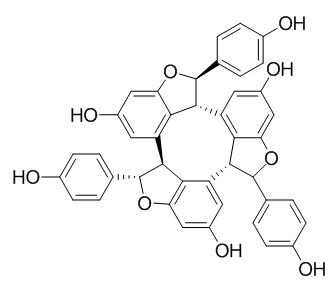Natural Products
alpha-Viniferin
| Catalog No. | CFN97068 |  |
| CAS No. | 62218-13-7 | |
| Molecular Weight: | 678.7 | |
| Molecular Formula | C42H30O9 | |
| DBs | [PubChem]:274953313 [ChEMBL]:66359 [PCIDB]:15693 |
Standard InChI:
InChI=1S/C42H30O9/c43-22-7-1-19(2-8-22)40-37-28-13-25(46)17-32-35(28)39(42(50-32)21-5-11-24(45)12-6-21)30-15-27(48)18-33-36(30)38(29-14-26(47)16-31(49-40)34(29)37)41(51-33)20-3-9-23(44)10-4-20/h1-18,37-48H/t37-,38-,39+,40+,41+,42-/m0/s1
Biological Activity
Alpha-viniferin isolated from Caragana chamlagu is a trimer of resveratrol, has anti-inflammatory, anti-oxidant, anti-arthritis, and anti-tumor activities;alpha-viniferin strongly inhibits 7 of the 9 CYP isoforms (except CYP2A6 and CYP2E1); alpha-viniferin strongly inhibits CYP2C19-mediated omeprazole 5-hydroxylation and CYP3A4-catalyzed midazolam 1-hydroxylation with IC 50 values of 0.93 and 1.2μM, respectively.[1]
(+)-Alpha-viniferin, a stilbene trimer from Caragana chamlague, inhibits acetylcholine
-sterase (AChE) activity in a dose-dependent manner, the IC50 value is 2.0 microM.[2]
Alpha-viniferin at doses> 30 mg/kg(p. o.) or > 3 mg/kg (i. v.)shows significant anti-inflammatory activity through inhibition of cyclooxygenase-2 and inducible nitric oxide synthase on carrageenin-induced paw edema in mice; alpha-Viniferin showed an inhibitory effect with an IC(50) value of 4.9 microM on COX-2 activity, but a very weak inhibitory effect at 100 microM on COX-1 activity; alpha-Viniferin inhibited synthesis of iNOS transcript with an IC50 value of 4.7 microM.[3]
Alpha-viniferin is a prostaglandin H2 synthase inhibitor, the inhibitory potency of (+)-alpha-viniferin is about 3- to 4-fold stronger than that of resveratrol on cyclooxygenase activity of prostaglandin H2 synthase partially purified from sheep seminal vesicles.[4]
Product
Official website: alpha-Viniferin
Japanese website: alpha-Viniferin
Chinese website: alpha-Viniferin
Japanese website: alpha-Viniferin
Chinese website: alpha-Viniferin
References
[1] Sim J, Jang H W, Min S, et al. Food Chem Toxicol , 2014, 69:276-80.
[2] Sung S H, Kang S Y, Lee K Y, et al. Biol Pharm Bull, 2002, 25(1):125-7.
[3] Chung E Y, Kim B H, Lee M K, et al. Planta Med, 2003, 69(8):710-4.
[4] Lee S H, Shin N H, Kang S H, et al. Planta Med, 1998, 64(3):204-7.
[5] Shu N, Zhou H, Hu C. Biol Pharm Bull, 2006, 29(4):608-12.
Product Use Citation





